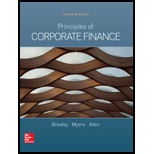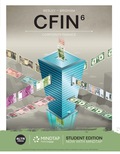
Principles of Corporate Finance
13th Edition
ISBN: 9781260465099
Author: BREALEY, Richard
Publisher: MCGRAW-HILL HIGHER EDUCATION
expand_more
expand_more
format_list_bulleted
Concept explainers
Question
Chapter 2, Problem 10PS
Summary Introduction
To determine: The PV paid in year 9.
Expert Solution & Answer
Want to see the full answer?
Check out a sample textbook solution
Students have asked these similar questions
Esfandairi Enterprises is considering a new three-year expansion project
that requires an initial fixed asset investment of $2,350,000. The fixed
asset will be depreciated straight-line to zero over its three-year tax life,
after which time it will be worthless. The project is estimated to generate
$3,310,000 in annual sales, with costs of $2,330,000. Assume the tax rate
is 23 percent and the required return on the project is 11 percent. What is
the project's NPV?
Note: A negative answer should be indicated by a minus sign. Do not
round intermediate calculations and round your answer to 2 decimal
places, e.g., 32.16.
Gyygvvv iiiedf
Need help in this question.hj
Chapter 2 Solutions
Principles of Corporate Finance
Ch. 2 - (FV) In 1880, five aboriginal trackers were each...Ch. 2 - Prob. 2SQCh. 2 - (PV) Your company can lease a truck for 10,000 a...Ch. 2 - (RATE) Ford Motor stock was one of the victims of...Ch. 2 - Prob. 5SQCh. 2 - Prob. 6SQCh. 2 - Prob. 7SQCh. 2 - (NOMINAL) What monthly compounded interest rate...Ch. 2 - Opportunity cost of capital Which of the following...Ch. 2 - Opportunity cost of capital Explain why we refer...
Ch. 2 - Prob. 3PSCh. 2 - Compound interest New Savings Bank pays 4%...Ch. 2 - Compound interest In 2017, Leonardo da Vincis...Ch. 2 - Future values If you invest 100 at an interest...Ch. 2 - Prob. 7PSCh. 2 - Future values In the five years preceding the end...Ch. 2 - Discount factors a. If the present value of 139 is...Ch. 2 - Prob. 10PSCh. 2 - Prob. 11PSCh. 2 - Present values What is the PV of 100 received in:...Ch. 2 - Prob. 13PSCh. 2 - Present values A factory costs 800,000. You reckon...Ch. 2 - Present values Recalculate the NPV of the office...Ch. 2 - Present values and opportunity cost of capital...Ch. 2 - Perpetuities An investment costs 1,548 and pays...Ch. 2 - Perpetuities You have just read an advertisement...Ch. 2 - Growing perpetuities A common stock will pay a...Ch. 2 - Prob. 20PSCh. 2 - Prob. 21PSCh. 2 - Annuities Kangaroo Autos is offering free credit...Ch. 2 - Annuities David and Helen Zhang are saving to buy...Ch. 2 - Prob. 24PSCh. 2 - Annuities Several years ago, The Wall Street...Ch. 2 - Prob. 26PSCh. 2 - Prob. 27PSCh. 2 - Prob. 28PSCh. 2 - Prob. 29PSCh. 2 - Annuities due A store offers two payment plans....Ch. 2 - Amortizing loans A bank loan requires you to pay...Ch. 2 - Amortizing loans Suppose that you take out a...Ch. 2 - Future values and annuities a. The cost of a new...Ch. 2 - Prob. 34PSCh. 2 - Growing annuities You are contemplating membership...Ch. 2 - Prob. 36PSCh. 2 - Growing perpetuities and annuities Your firms...Ch. 2 - Compounding intervals A leasing contract calls for...Ch. 2 - Compounding intervals Which would you prefer? a....Ch. 2 - Compounding intervals You are quoted an interest...Ch. 2 - Prob. 41PSCh. 2 - Continuous compounding How much will you have at...Ch. 2 - Continuous compounding The continuously compounded...Ch. 2 - Prob. 44PSCh. 2 - Annuities Use Excel to construct your own set of...Ch. 2 - Declining perpetuities and annuities You own an...
Knowledge Booster
Learn more about
Need a deep-dive on the concept behind this application? Look no further. Learn more about this topic, finance and related others by exploring similar questions and additional content below.Similar questions
- AP Associates needs to raise $35 million. The investment banking firm of Squeaks, Emmie, andChippy will handle the transaction.a. If stock is used, 1,800,000 shares will be sold to the public at $21.30 per share. The corporation willreceive a net price of $20 per share. What is the percentage underwriting spread per share?b. If bonds are utilized, slightly over 37,500 bonds will be sold to the public at $1,000 per bond. Thecorporation will receive a net price of $980 per bond. What is the percentage of underwritingspread per bond? (Relate the dollar spread to the public price.)c. Which alternative has the larger percentage of spread?arrow_forwardGracie’s Dog Vests currently has 5,200,000 shares of stock outstanding and will report earnings of$8.8 million in the current year. The company is considering the issuance of 1,500,000 additionalshares that will net $28 per share to the corporation.a. What is the immediate dilution potential for this new stock issue?b. Assume that Grace’s Dog Vests can earn 8 percent on the proceeds of the stock issue in time toinclude them in the current year’s results. Calculate earnings per share. Should the new issuebe undertaken based on earnings per share?arrow_forwardYou plan to contribute seven payments of $2,000 a year, with the first payment made today (beginning of year 0) and the final payment made at the beginning of year 6, earning 11% annually. How much will you have after 6 years? a. $12,000 b.$21,718 c.$19,567 d.$3,741arrow_forward
arrow_back_ios
SEE MORE QUESTIONS
arrow_forward_ios
Recommended textbooks for you
 Intermediate Financial Management (MindTap Course...FinanceISBN:9781337395083Author:Eugene F. Brigham, Phillip R. DavesPublisher:Cengage Learning
Intermediate Financial Management (MindTap Course...FinanceISBN:9781337395083Author:Eugene F. Brigham, Phillip R. DavesPublisher:Cengage Learning

Intermediate Financial Management (MindTap Course...
Finance
ISBN:9781337395083
Author:Eugene F. Brigham, Phillip R. Daves
Publisher:Cengage Learning
